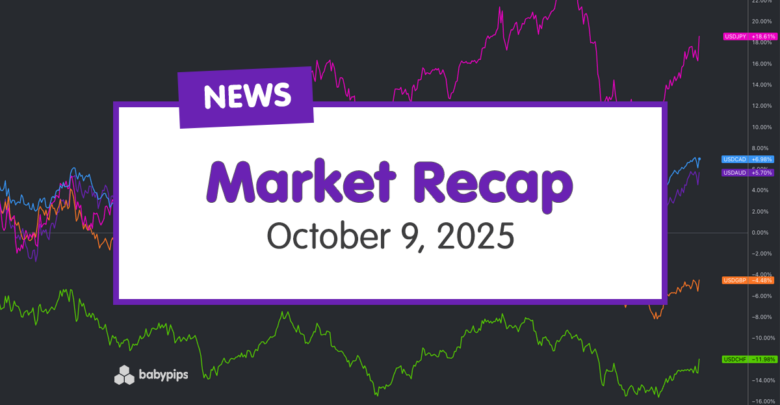
Markets took a breather on Thursday, with equities pulling back from record highs while geopolitical safe-haven assets declined following the start of a Gaza ceasefire, as traders navigated ongoing concerns about the U.S. government shutdown and parsed cautious commentary from Federal Reserve officials.
The subdued price action reflected a market in transition, as the ninth day of the federal government shutdown continued to delay key economic data releases while geopolitical tensions eased with the implementation of the Israel-Hamas ceasefire agreement.
Check out the headlines and economic updates you may have missed in the latest trading session!
Headlines & Data:
- China introduced new restrictions on rare earth exports on Thursday
- U.K. RICS House Price Balance for September 2025: -15.0% (-18.0% forecast; -19.0% previous)
- Australia Consumer Inflation Expectations for October 2025: 4.8% (4.5% forecast; 4.7% previous)
- Germany Balance of Trade for August 2025: 17.2B (16.1B forecast; 14.7B previous)
- Germany Imports for August 2025: -1.3% m/m (-0.6% m/m forecast; -0.1% m/m previous)
- Germany Exports for August 2025: -0.5% m/m (0.5% m/m forecast; -0.6% m/m previous)
- Japan Machine Tool Orders for September 2025: 9.9% y/y (8.5% y/y forecast; 8.1% y/y previous)
- In a speech on Thursday, Bank of Canada Senior Deputy Governor Rogers warned against overregulation of the financial sector
- Federal Reserve Chairman Jerome Powell spoke today at the Community Bank Conference; offered no comments on interest rates or the broader economy
- Fed Governor Barr called for a cautious approach to additional interest rate cuts
- The Gaza ceasefire began on Thursday after Israel and Hamas reached a ceasefire agreement earlier in the week
- The U.S. government shutdown enters its 9th day with no signs of progress; the general public begins to feel the effects of government closure.
Broad Market Price Action:

Dollar Index, Gold, S&P 500, Oil, U.S. 10-yr Yield, Bitcoin Overlay Chart by TradingView
Markets experienced choppy trading throughout Asian and London sessions before witnessing a coordinated decline in risk assets during the U.S. afternoon, as the official start of the Gaza ceasefire appeared to drain some urgency from safe-haven positioning.
The S&P 500 retreated from fresh record highs, declining 0.39% to close at 6,735.11 after briefly touching intraday highs earlier in the session. The pullback represented the first meaningful pause in a rally that had seen the index climb more than 36% from April’s lows. Technology shares led the retreat, though Oracle and Nvidia provided some support.
Gold pulled back notably from its historic run above $4,000 per ounce, declining approximately -1.59% to trade around $3,977 as the Gaza ceasefire announcement prompted profit-taking in geopolitical safe-haven positions. Despite the pullback, the precious metal remained supported by expectations for continued Federal Reserve rate cuts and ongoing concerns about the U.S. government shutdown.
WTI crude oil extended its decline, falling over 1% to around $61 per barrel as the ceasefire in Gaza reduced Middle East risk premiums and overshadowed ongoing concerns about OPEC+ production policy and the delayed U.S. inventory data due to the government shutdown.
Bitcoin experienced its sharpest decline in the recent period, dropping 1.5% to trade around $121,045 after having reached a record high of $126,223 on Monday. The cryptocurrency’s retreat coincided with broader risk-off sentiment and profit-taking from the “US government shutdown” trade following its remarkable run.
The 10-year Treasury yield climbed approximately 3 basis points to 4.14% as bond markets likely reacted Fed Governor Barr’s cautious commentary on rate cuts, which emphasized elevated inflation risks and the need for a measured approach to policy adjustments. The move higher in yields contrasted with the decline in risk assets, suggesting some reassessment of the pace of future Fed easing.
FX Market Behavior: U.S. Dollar vs. Majors:

Overlay of USD vs. Majors Chart by TradingView
The U.S. dollar posted broad-based gains on Thursday, rallying against most major currencies in a display of strength that defied the ongoing government shutdown and benefited from safe-haven flows as well as repositioning ahead of key employment data.
The greenback’s path during the Asian session was choppy, initially declining against major currencies before finding support and beginning to rebound ahead of the London open. This turn roughly correlated with news that Hamas accepted President Trump’s peace plan to end the war in Gaza.
At the London open, the dollar extended its rebound before experiencing a mid-morning reversal that saw the currency pull back against most majors. There were no notable catalysts to point to, so this temporary weakness likely coincided with European trading activity and may have reflected position adjustments as traders awaited further clarity on U.S. policy developments.
The decisive move came during the U.S. trading session, when the dollar mounted a sustained rally that carried through the afternoon. Fed Chair Powell had a speech during this time frame, but made no comment on interest rates or the economic outlook, and this move was ahead of Fed Governor Barr’s speech emphasizing caution on rate cuts and highlighting elevated inflation risks.
So, an argument could be made that capital flowed from “geopolitical + alternative safe havens” (gold, oil, and bitcoin) ahead of the official start of the Gaza War ceasefire, as well as possible flows from equities and bonds, most likely profit taking from recent momentum moves.
By the session close, the dollar had posted gains across the board, with particularly strong performance against the British pound (+0.73%), New Zealand dollar (+0.70%), and euro (+0.56%).
The dollar’s strength despite the government shutdown and delayed economic data releases suggests that concerns about global growth, fiscal challenges in Europe, and political uncertainty in major economies continue to support demand for the greenback as a relative safe haven.
Upcoming Potential Catalysts on the Economic Calendar
- New Zealand Business NZ PMI for September 2025 at 9:30 pm GMT
- Australia RBA Bullock Speech at 10:00 pm GMT
- Australia RBA Kent Speech at 10:00 pm GMT
- Japan Bank Lending for September 2025 at 11:50 pm GMT
- Japan PPI for September 2025 at 11:50 pm GMT
- Swiss Consumer Confidence for September 2025 at 7:00 am GMT
-
Canada Employment Change for September 2025 at 12:30 pm GMT
- Canada Unemployment Rate for September 2025 at 12:30 pm GMT
- Canada Average Hourly Wages for September 2025 at 12:30 pm GMT
- U.S. Fed Goolsbee Speech at 1:45 pm GMT
- U.S. University of Michigan Consumer Sentiment Index for October 2025 at 2:00 pm GMT
- U.S. Michigan Inflation Expectations Prel for October 2025 at 2:00 pm GMT
- U.S. Fed Musalem Speech at 5:00 pm GMT
- U.S. Monthly Budget Statement for September 2025 at 6:00 pm GMT
Friday’s calendar features critical employment data from Canada and key consumer sentiment readings from the United States.
The Canadian employment report will be closely watched for signs of labor market cooling, particularly given the impact of U.S. tariffs on Canadian exports.
The University of Michigan Consumer Sentiment survey takes on added importance as it will provide the first comprehensive reading on consumer attitudes since the government shutdown began, while the inflation expectations component could influence Federal Reserve policy considerations.
Any significant deterioration in either report could intensify concerns about economic momentum.
Multiple Fed speakers throughout the day may provide additional color on the central bank’s reaction function, and updates on the status of shutdown negotiations could also drive market volatility if progress emerges toward a resolution.
Stay frosty out there forex friends and don’t forget to check out our Forex Correlation Calculator when taking any trades!
Source link








